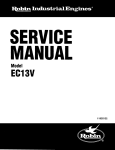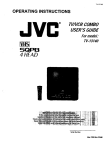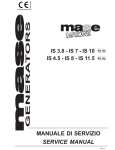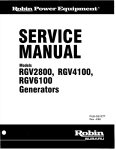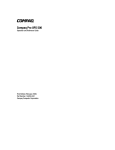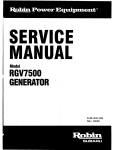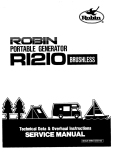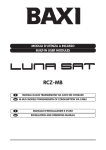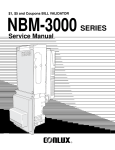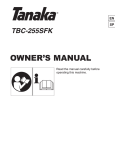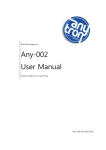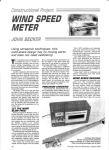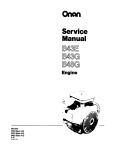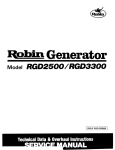Download RGD2500 & RGD3300 GENERATOR SERVICE MANUAL
Transcript
SERVICE MAIUUAL - -- Model RGD2500,RGD3300 Generator PUB-GS1186 Rev. 8198 CONTENTS Section Page 1 SPEClFlCATlONS....................................................................................................... 1 Tile . . 2 PERFOMANCE CURVES........................................................................................... 2 2-1 MODEL RGD2500 ................................................................................................. 2-2 MODEL RGD3300 ................................................................................................. 2-3 DC OUTPUT ......................................................................................................... 2 2 2 .................................................................................................................. 3 . 3 FEATURES .......................................................................................... . 4 GENERAL DESCRIPTION 4-1 EXTERNAL VIEW ................................................................................................. 4-2 CONTROL PANEL ................................................................................................ 4 4 5 4-3 LOCATION of SERIAL NUMBER and SPECIFICATION NUMBER...................... 6 ........................................................................... 7 . 5 CONSTRUCTION AND FUNCTION 5-1 CONSTRUCTION ................................................................................................. 7 5-2 FUNCTION ............................................................................................................ 7 5-3GENERATOR OPERATION................................................................................ 11 . ......................................................................................... 7. RANGE OF APPLICATIONS .................................................................................... 8. MEASURING PROCEDURES.................................................................................. 6 SAFETY PRECAUTIONS 8-2 AC OUTPUT MEASURING ................................................................................. 15 18 18 21 8-3DC OUTPUT MEASURING................................................................................. 21 8-4 MEASURING INSULATION RESISTANCE ........................................................ 22 24 24 24 24 25 26 26 27 29 29 8-1 MEASURING INSTRUMENTS ........................................................................... . . 14 .................................................................... 9 CHECKING FUNCTIONAL MEMBERS 9-1 VOLTMETER ....................................................................................................... 9-2 AC RECEPTACLES ............................................................................................ 9-3 NO-FUSEBREAKER ........................................................................................... 9-4 STATOR .............................................................................................................. 9-5 ROTOR ASSEMBLY........................................................................................... 9-6 CONDENSER ..................................................................................................... 9-7 DIODE RECTIFIER ............................................................................................. 10.DISASSEMBLY AND ASSEMBLY 10-1 PREPARATION and PRECAUTIONS ............................................................... .......................................................................... Section Title Page 10-2 SPECIAL TOOLSfor DISASSEMBLY and ASSEMBLY .................................... 29 10-3DISASSEMBLY PROCEDURES ....................................................................... 30 10-4 ASSEMBLY PROCEDURES ............................................................................. 38 10-5 CHECKING. DISASSEMBLY and REASSEMBLY of the CONTROL BOX ....... 51 t 1 TROUBLESHOOTING 53 11-1 NO AC OUTPUT ................................................................................................ 53 11-2 AC VOLTAGEI S TOO THIGH OR TOO LOW................................................... 54 11-3AC VOLTAGE IS NORMAL AT NO.LOAD. BUTTHE LOAD CANNOT BE APPLIED .....55 11-4 NO DC OUTPUT............................................................................................... 56 11-5 OIL SENSOR TROUBLE SHOOTING ....................... ....................................... 57 12 WIRING DIAGRAM................................................................................................. 58 . . ............................................................................................ r Model RGD3300 RGD2500 Brushless, Self Exciting, 2-Pole, Single Phase I Frequency I 60 Hz 60 Hz Maximum Output 2500 W 3300 W Rated Output 2200 W 3000 W I I I U 0 AC sz a W 5 a 120 v Rated Current Voltage 120 v 18.3 A 120V/240V 25.0N 12.5A 120Vl240V 18.3N 9.2A 1.o Power Factor 12 V-8.3 A (100 W) DC Output Condenser Type Voltage Regulator Air-Cooled CCycle, Diesel Engine Type Model I DY23-2D I Displacement Rated Output i I 230 cm3 (14.04 cu. in.) 4.8 HP / 3600 rpm Fuel Tank Capacity ~~~ ~ Rated Coutinuous Operation I 5.5 HP / 3600 rpm light oil Fuel I 1.10 hours hours 1.30 0.9 liters Recoil Starter and Optional Electric Starter - Starting System I ! I 2.06 U.S. gal. (7.8 liters) Oil Capacity I Dimensions (Lx W x H) I Dry Weight 265 cm3 (16.17 cu. in.) I Diesel ~~ DY27-2D i ~ ~ 25.0 A 21.1 ~ 1 5 . 8 ~ 1 8 . 0 i n ( 2 7 . 9 ~ 1 5 . 8 ~ 1 8 . 0 i n ) ’ / 5 3 6 ~ 4 0 0 ~ 4 5 8 mm (709 x 400 x.458 mm)* I I 55 kg(58.5kg.)’ / 121 Ibs. (129 Ibs.)’ Electric starter motoris available asoption. - 1- 58.5 kg (62 kg.)’ / 128.7 Ibs. (137 I&.)* 2. PERFOMANCE CURVES 2-1 MODEL RGD2500 Output Max. ................. 2500 W Output Rated ............... 2300 W Frequency .................... 60 Hz Voltage ......................... 120 V - 2k ts A - lk a n I3 O - 0 CURRENT(A) - 2-2MODEL RGD3300 3k 2k t Output Max. .............. 3300 W Output Rated ............3000 W Frequency .................60 Hz 120 V/240V Voltage ...................... e CI 3 Y 0 CURRENT (A) + 2-3DC OUTPUT DC Voltage ..................12 V DC Ampere .................8.3A v 5 DC output .................... 100 W 16 14 The voltage curve shown in the left indicates the characteristic of DC output when charginga battery. The voltage may be decreased by 20% when the resistance load is applied. 12 g 10 NOTE :It is possibleto use bothDC and AC outputs simultaneously upto the rated outputin total. 0 2 4 6 CURRENT(A) 8 1 " + 0 - 2- 3-1 BRUSHLESSALTERNATOR Newly developed brushless alternator eliminates troublesome brush maintenance. 3-2 EASYSTARTING Light pull recoil starter accompanied with automatic decompression system makes the new RGD series generators even easier in starting than gasoline engine generators. 3-3 QUIET OPERATION The new KGD series generator provides quiet operation by means of: The superb design of intake-exhausr system. Direct injection combustion system. A large super silent muffler. An efficient low noise air cleaner. 3-4 ECONOMICALPERFORMANCE On top of well known diesel economy. the air-coolea Robin diesel engine features direct fuel injection and special design refinemem for extra fuel efficiency. 3-5 OIL SENSOR The OIL SENSOR automatically shuts the engine off whenever the level oil falls down below a safelevel preventing engine seizure. 3-6 COMPACT, LIGHT WEIGHT The combination of newiy developed brushless alternator and air-cooled single cylinder Robin diesel engine enables the newRGD series generators t o be very compact in size and lightin weight. 3-7 RELIABLEPERFORMANCEWITH MINIMAL MAINTENANCE A brushless alternator eliminates troublesome brush maintenance. A drip-proof alternator design. A trouble free condenser voltage regulator. A fuseless circuit breaker. A dust-proof dual element air cleaner. The OIL SESSOR automatically shuts the engine off whenever the oil level falls down below a safe level preventing engine seizure. 3-8 LONG-LIFEDURABILITY C'onlpact and smooth running air-cooledRobindieselenginelastsmuchlongerthanthegasoline engine of the same size. Trouble-freebrushlessalternatorwithcondensertypevoltageregulatorworksalltheyearround without any maintenace work. - 3- 4.GENERAL DESCRIPTION 4-1 EXTERNAL VIEW Speed control lever Rocker cover No-fuse Full mwer switch ( D U voltage ~ type o Ibmakei / / Air cleaner / Key switch (Only for RGD3300) \ Fuel injection pump \ Stop lever DC output terminal / Earth terminal Oil fi&r Fuel filter Muffler / Electric starter (only for RGDSOO) \ Oil gauge - 4- . cock Fuel 4-2 CONTROL PANEL RGD2500, RGD3300 :60HZ-l20V, 60H~-120V/240VTYPE Full power switch / No-fuse breaker Key switch (Only for RGD3300) i, Vottmeter @ DC output terminal _- I(( 11 /Ac 7 receptacle / Earth terminal DC fuse - 5- 4-3 LOCATION of SERIAL NUMBER and SPECIFICATION NUMBER Serial number and specification number are stamped on the LABEL (MODEL NAME) stuck on the side wal of control box. NOTE :Always specify these numbers when inquiring about the generator or ordering spare parfs in order to get correct parts and accurate service. Specifications label - 6- w 5.CONSTRUCTION AND FUNCTION Generator Mount base rubber Ball bearing Through bolt Support ring Fig- 5-7 5-2 FUNCTION 5-2-1 STATOR The stator consistsof a laminated silicon steel sheet core, a main coil and a condenser coil which are woundin the coreslots. The condenser coil excites the rotor coilfield which generates AC voltage in the maincoil. Fig. 5-2 - 7- Front cover 5-2-2 CONDENSER One or two condensers areinstalled in the control box and are connectedto the condenser coil of the stator. These condensers and condenser coil regulate the output voltage. I Fig. 5 3 5-24 ROTOR The rotor consists of a laminated silicon steel sheet core anda field coil whichis wound over the core. DC current in the field coil magnetizesthe steel sheet core. Two permanent magnetsare provided for the primary exciting action. Fig. 5-4 A diode rectifier and surge absorberis mounted inside of the insulator. Diode rectifier andSurge absorber Fig. 5-5 - a- 5-2-4 DC FUSE (1) The 10 ampere DC fuse mountedon the control panel protects whole DC circuit from getting damage by overload or short circuit. (2) The 15 ampere DC fusein the control box protects the diode rectifier from getting damage by reverse connectionto thebattery. (Electric start model) I Fig. 5-6 5-2-5 NO-FUSE BREAKER The no-fuse breaker protects the generator from getting damage by overloading or shortincircuit the appliance.Table 5-1 shows the capacrty of no-fuse breaker by each spec. and their object of protection. MODEL RGD2500 RGD3300 SPECIFICATION 60 HZ-120V NO-FUSE BREAKER 20 A OBJECT or PROTECTION 60 HZ-120 V, 240V 10Ax2 Total output amperage 60 HZ-120 V 27 A Total output amperage 14Ax2 Total output amperage 60 HZ-1 20 V, 240V Total output amperage Table. 5-1 1 Fig. 5-7 - 9- 5-2-6 RECEPTACLE and AC PLUG (STD.SPEC.) These are used for taking AC output power from the generator. A total of six kindsof receptacles, each varying in rated voltage and current from another, are used. Each model has at least one receptacle to deliver the rated generator output. As many AC plugsas the receptacles, each matching the correspond5-2 shows the rated current for each receptacle. Be careful not to use ing receptacle, are provided. Table the receptacles and AC plugs beyond the specified amperage limits to prevent burning. w NOTE 7 :If your generator has receptacles peculiar to your county, Table 5-2 does not apply. NOTE 2 :The generator for U.S.A. market is equipped withNEMA standard receptacles shownin table 5-2. Use the proper plug for connecting appliance to the generator. Caution : To connect the appliance to locking receptacle, insertthe plug intothe receptacle andturn it clockwise tolock. Fig. 5-8 Style ~1 @ Ampere 125V 20A Receptacle AC plug 5-20R NEMA 5-20P 125VI 250V NEMA NEMA 20A 125V 30A NEMA L5-30 Table. 5-2 - 10- Description GFCl NEMA (Ground Fault Circuit interrupter) Receptacle, duplex Locking Receptacle L14-2OP L14-20R NEMA L5-30P Locking Receptacle 5-3GENERATOR OPERATION PERMANENT MAGNET STATOR FOR INITIAL EXCITATION r--1 I FIELD COIL MAIN COIL \ " " " 1 I ""I Fig. 5-9 5-3-1GENERATION Of NO-LOAD VOLTAGE (1) When the generator starts running, the permanent magnet built-in to the rotor generates 3 to 6V of AC voltage inthe main coil and condenser coil wound on the stator. (2) As one or two condensers are connected to the condensercoil, the small voltage at the condenser 8) which flows through the condenser coil. At this time,a small fluxis coil generates a minute current produced with which the magnetic force at the rotor's magnetic pole is intensified.When this magnetic force is intensified, the respective voltages in the main coil and condenser coil As risethe up. current 3 increases, the magnetic flux at the rotor's magnetic pole increases further. Thus the voltby repeating this process. ages at the main coil and condenser coil keep rising (3) As AC current flows through the condenser coil, the density of magnetic in theflux rotor changes. This in the field coil change of magnetic flux inducesAC voltage in the field coil, and the diode rectifier AC voltage into DC. Thus a DC current 13flows through the field coil and magnecircuit rectifies this tizes the rotor core to generate an output voltage in the main coil. (4) When generator speed reaches3000 to 3300 rpm, the currentin the condenser coil and field coil of each coils. If generator speed further increases rapidly. This acts to stabilize the output voltage will reach to the rated value. increases to the rated value, the generator output voltage 5-3-2 VOLTAGE FLUCTUATIONS UNDER LOAD When theoutput current @ flows through the main coil to the appliance, a magnetic is produced flux and @ in the condenser coil. When current @ increases, the densityof magnetic serves to increase current flux acrossthe rotor core rises.As a result, the current flowing in the field coil increases and the generator output voltage is prevented from decreasing. - 11 - 5-3-3 FULL POWER SWITCH (Dual Voltage Type) The full power switchis provided for the dual voltage type to take out the full rated power from one receptacle in each voltage. 1" REc21& -1 1OV) $"" / Fig. 5-11 I - , 1 IREC1 I 110 v ,orv 1 I I LOWER VOLTAGE HIGHER VOLTAGE RECEPTACLE RECEPTACLE Rated output I No output can be taken. I 110/220 v or Half of rated output 120/240 V Tale. 5-4 Fig. 5-12 - 12- Rated output Two main coils are wound over stator core. Each main coil outputs half the rated power at the lower voltage (11OV or 12OV). These main coils are wound to in bethe same phase. Thefull power switch reconnects these main coils in parallel orin series. Fig. 5-10 shows a circuit diagram. Whenthe fullpower switchis set for single lower voltage indication (11OV or 12OV), the switch positionis as indicated by the lower solid line in the diagram. Fig. 5-11 is a simplified representation of this circuit, showing two themain coils connected in parallel.ln this case, the 2 for the lower voltage can output up higher voltage(22OV or 240v) at Rec. 3 cannot be taken out. Rec. to the rated power (up30A to if the rated currentis over 30A), and Rec.1 can output up toa total of 15A. When the fullpower switch is set for double voltage indication (11OV/22OV or 120V/240V), the switch position is as indicated by the upper dotted line 5-10. in Fig. Fig. 5-12 is a simplified representation of this circuit, showing thetwo main coils connectedin series. In thiscase, powercan be taken simultaneously 3 for the higher voltage can outputtoup the rated power, from the receptacles for the both voltages. Rec. but Rec. 1 and Rec.2 for the lower voltage can output only up to half the rated power each. Table 5-4 is a summary of the above explanation. Select the proper output voltage by full powerinswitch accordance withthe appliance to beused. " - 13- 6.:SAFETY PRECAUTIONS 1. Use extreme caution near fuel. A constantdanger of explosion or fire exists. Do not fill the fuel tank while the engine is running. Do not smoke or use opem flame near the fuel If spilt, wipeit and let dry before starting the engine. tank. Be careful not to spill fuel when refueling. 2. Do not place inflammable materials near the generator. Be careful not to put fuel, matches, gunpowder, oily cloth, straw, and any other inflammables near the generator. 3. Do not operate the generator in a room,cave or tunnel. Always operatein a well-ventilated area. Otherwise the engine may overheat and also, the poisonous carbon monoxide contained in the exm (4 feet) away from structures haust gases will endanger human lives. Keep the generator at1least or facilities during use. 4.Operate the generator on a level surface. If the generatoris tilted or moved during use, there is a dangerof fuel spillage and a chance that the generator may tip over. 5. Do not operate with wet hands or in the rain. If the generatoris wet by rain or snow, wipe it and thoroughlydry it Severe electric shock may occur. before starting.Don't pour water overthe generator directly nor wash it with water. If the generator is will be adversely affected and may cause current leakage and electric wet with water, the insulations shock. 6. Do not connect the generator to commercial the w power lines. This may cause a short-circuit or damage to the generator. Use a transfer switch (Optional parts) for connecting with indoor wiring. NOTE :The parts numbersof the transfer swifches and of the plastic box to store them are as shown in Table 6-1. Part No. Name Part Q'ty Phase Allowable Current 365-45604-08 Transfer 1Switch 1 15 A 367-45605-08 Transfer 1Switch 1 30 A 340-45606-08 Transfer Switch 1 367-43008-08 Plastic1Box 1 30 A 348-43009-08 Plastic 60 Box1 1 A 1 60 A Table. 6-1 7. Be sureto check andremedy thecause of circuit breaker tripping before resetting it on. CAUTION : If the circuitbreaker tripped off as a resultof using anelectrical appliance,the cause In such a case, stop operationimmediately and carefully can be an overload or a short-circuit. check theelectrical appliance and AC plugs for faulty wiring. - 14- Generally, the power rating of an electrical appliance indicates the amount of work that can be it.done by The electric power required for operating an electrical appliance is not always equal to the output wattage of the appliance. The electrical appliances generally have a label showing their rated voltage, frequency, and power consumption (input wattage). The power consumption of an electrical appliance is the power necessary for using it. When using a generator for operating an electrical appliance,the power factor and starting wattage must be taken into consideration. total wattage of all appliancesto In order to determine the right size generator, it is necessary to add the be connectedto the unit. Refer to the followings to calculate the power consumption of each appliance or equipment by its typ (1) Incandescent lamp, heater, etc. with a power factor of1.O Total power consumption must be equal to or less than the rated output of the generator. Example :A rated 3000W generator can turn thirty lOOW incandescent lamps on. (2) Fluorescent lamps, motor driven tools, light electrical appliances, etc. with a smaller power factor Select a generator with a rated output equivalent 1.2toto 2 times of the power consumption of the 1.2 are to 3 load. Generally the starting wattage of motor driven tools and light electrical appliances times lager than their running wattage. Example : A rated 250 W electric drill requires400 a W generator to starti t . NOTE 7 :If a power factor correction capacitor is not applied to the fluorescent lamp, the more powe shall be required to drive the lamps. of the lamp. NOTE2 :Nominal wattage of the fluorscent lamp generally indicates the output wattage efiTherefore, if the fluorescent lamp has no special indication as to the power consumption, ciency should be taken into account as explained in item (5) on the following page. (3) Mercury lamps witha smaller power factor Loads for mercury lamps require 2 to 3 times the indicated wattage during start-up. Example :A 400 W mercury lamp requires 800 W to1200 W power source to be turned Aon. rated 3000 W generator can powertwo or three400 W mercury lamps. (4) Initially loaded motor driven appliances suchas water pumps,compressors,etc. These appliances require large starting wattage which is 3 to5 times of running wattage. Example :A rated 900 W compressor requires a 4500 W generator to drive it. NOTE 7 :Motor-driven appliances require the aforementioned generator output at the only shdng. Once 7.2 to 2 times their rated power contheir motors are started, the appliances consume about used forother electrical sumption so that the excess power generated by the generatorbecan appliances. (4) vary in their required motorsbrting NOTE2 :Motor-driven appliances mentioned in Items(3) and power depending on the kind of motor and start-up if itload. is dficult to determine theoptimum generator capacw, select a generator with a larger capaciw. - 15- (5) Appliances withoutany indication as to power consumption Some appliances have no indication as to power consumption; but instead the work load (output) is indicated. In such a case, power consumption is to be worked out accordingto the numerical formula mentioned below. (Output of electrical appliance) (Efficiency) = (Power consumpition) Efficiencies of some electrical appliances are as follows : Single-phase motor................................ Fluorescent lamp ................................... The smaller the motor, the 0-753( lower the efficiency. Oe6 0.7 to to 0.8 Example 1: A 40W fluorescent lamp means that its luminous output is 40W. Its efficiencyis 0.7 and accordingly, power consumptionwill be40 t 0.7=57W. As explained in Item (2), multiply this power consumption value of 57 W by 1.2 to 2 and youwill get the figure of the necessary capacity of a generator.In other words, a generator with a rated ooutput f 1OOOWcapacity can light nine to fourteen 40 W fluorescent lamps. Example 2 : Generally speaking, a400 W motor means that its work load is 400 W. Efficiency of this 400+0.7= 570 W. When this motoris used for motor is0.7 and power consumption will be a motor-driven tool, the capacity of the generator should be multiple of 570W by 1.2to 3 as (3).570 (W) x 1.2 to 3 = 684 (W) to 1710(W) explained in the Item MODEL RGD3300 RGD2500 Frequency lncandesent lamp, heater, etc. I 60 Hz I 22OOw Fluorescent lamp, Motordriven tool, general-porpose ~~~~~ Mercury lamp, etc. Pump, compressor, etc. I I approx. 13OOW 1 approx. 650 W Table. 7-1 - 16- 30OOW approx. approx. 15OOW 1 60 Hz 2100 w I approx. 18WW approx. I NOTES : Wring between generator and electrical appliances " I. Allowable current of cable. Use a cable with an allowable current that is higher than the rated input current of the load (el of the cable used, the cable will appliance). If the input current is higher than the allowable current become excessively heated and deteriorate the insulation, possibly burning it out. 7-2 Table shows cables and their allowable currents for your reference. 2. Cable length occurs due to the increased resistance in the conductors deIf a long cable is used, a voltage drop damaged.Tabe creasing the input voltage to the load (electrical product). As a result, can thebeload 7-2 shows voltage drops per I00 meters of cable. Sectional A"owab'e area / mm3 current / A " Gauge No' wire dement mm Voltage drop per 100 m Resistance Ohm/100m 1~ 3~ 0.75 7 I 3010.18 I 2.477 1.25 12 50 10.18 1.486 1.5V 5V 7.5V 2.0 17 0.952 1.0 V 3V 5.0 V 3.5 23 10.26 37 I 45/0.32 I I 2.5 V I 8 V 5~ 0.517 I 112.5 V I 1.5V I 2.5 V 5.5 4V I 5 V 16.5V 2.5v I 35-v I 4v 7.5 v 5v I I Table. 7-2 Voltage drop indicates as V= 1 x RxIxL 100 R meansresistance ( hz / 100 m)on the above table. I meanselectriccurrentthroughthewire L meansthelength of thewire (A). (m). The length of wire indicaters round length, it means twice the length from generator to electrical tools. - 17- r 8-1 MEASURING INSTRUMENTS 8-1-1 “Dr. ROBIN” GENERATOR TESTER The “Dr. Robin” generator tester is exclusively designed for fast, easy diagnosis and repair of Robin generators. The “Dr. Robin” has the following features: (1) Functions of voltmeter, frequency meter, meggertester, capacitance meter and circuit tester are combined in one unit. (2) Fast and easy readout by digital indicator. (3) Built-in automatic battery checker indicates the time to change batteries. Fig. 8-1 (4) Tester and accessories are installed in a handy, sturdy case for easy carring. SPECIFICATIONS MODEL I Dr.Robin Part Number 388-47565-08 0 to 500 V AC Voltage 25 to 70 Hz Frequency Measuring Resistance Range Condenser Capacity 0.1 to 1.999 Q 10 to 100 p F insulation Resistance 3M Q Fuse Circuit Protector 2 x 6F44P (006P)Dry Cell Battery Power Source I Accessories Test Leads with needle probes . . . 1 set Test leads with jack plugs . . . 1 set Dimensions (L x W x H) I 285 mrn x 200 mm x 110 mrn 1.6 kg Weight Table. 8-1 The “Dr. Robinngenerator tester can be ordered from Robin generator distributors by the following part number. Dr. Robin Part Number :388-47565-08 If youdo not have a “Dr. Robinngenerator tester,use the instruments described in the following section for checking generator parts. - 18- 8-14 INSTRUMENTS (1) VOLTMETER AC voltmeter is necessary. The approximate AC voltage ranges of the voltmeters used to be for various types of generators are as follows: 0 to 150V:Type with an output voltage of 110 or 120V 0 to 3OOV :Type withan output voltage of 220, 230 or 240V 0 to 150V, 0 to 330V : Dual voltage type FOR AC Fig. 8-2 (2) AMMETER AC ammeter is necessary. An AC ammeter with a range that can be changed according to the current ratingof a given generator is most desirable. (About1OA, 20A, 1OOA) FOR AC Fig. 8-3 (3) FREQUENCY METER I Frequency range:About 45 to 65Hz NOTE :Be carefulof the frequency meter's input voltage range. Fig. 8 4 - 19- (4) CIRCUIT TESTER Used for measuring resistance, etc. Fig. 8-5 (5) MEGGER TESTER Used for measuring generator insulation resistance. Select one with testing voltage range of 500V. I Fig. 8-6 (6)TACHOMETER Use the contactless type tacho meter. Fig. 8-7 - 20- 8-2 AC OUTPUT MEASURING TO AC Fig. 8-8 Use a circuit like the shown in Fig.8-8 for measuringAC output. A hot plate or lamp with a power factor of 1.O may be usedas a load. Adjust the load and rpm. and check that the voltage range is as specified in Table 8-2 at the rated amperage and rated rpm. Rated voltage 120 v 117 -130 V Voltage range 240 v - 235 260 V Table. 8-2 8-3 DC OUTPUT MEASURING d To DC Terminal Q ?? i. "I fig. 8-9 Measurement ofDC output is executed with the switch turned ON while the current is regulated8.3A at by adjusting the load to the generator. If the voltageis within the range from 6V to 14V, the voltageoutput is normal. NOTE :If a battery is connected as a load to the generator, theDC output voltage will increase by approximately 1 to 2 K Therefore, carefully observe the electrolyte level and do not overcharge the battery. - 21 - WMEASURING INSULATION RESISTANCE Use a "Dr. Robinngenerator tester in megger tester mode or use a megger tester to check the insulation resistance. Connect a megger tester to one of receptacle output terminals and the ground terminal, then measure the insulation resistance. An insulation resistance of1 megohm or more is normal. (The original insulation resistance at the time of shipment from the factory is 10 megohm or more.) If it is less than Imegohm, disassemble the generator and measure the insulation resistance of the stator, rotor and control panel individually. Fig. 8-10 STATOR (1) Measure the insulation resistance between BLUE lead and the core. (2)Measure the insulation resistance between WHITE lead and the core. (3) Measure the insulation resistance between YELLOW lead and the core. (4) Measure the insulation resistance between BROWN lead and the core. 1 Fig. 8-11 ROTOR Measure the insulation across one aIf the solderec terminals of the rotor andthe core. - 22- CONTROL PANEL .- I Measure the insulation resistances between the live parts and the grounded parts. Fig. 8-13 Any part wherethe insulation resistance is less than 1M Q has faulty insulation, and may cause electric leakage and electric shock. Replace the faulty part. - 23- e 9.CHECKING FUNCTIONAL MEMBERS w 9-1 VOLTMETER Check the the voltmeterit is if tumed on by applying specific voltage. Voltmeter cannot be checked with circuit tester because its resistance is too large. 9-2 AC RECEPTACLES Using a "Dr. Robinnor a circuit tester, check continuity between the two terminals at the rear of the AC receptacles while the receptacle is mounted on VOLTMETER Fig. 9-1 When continuity is found between the output terminals of the receptacle with a wire connected across these terminals, theAC receptacle is normal. When the wireis removed and no continuity is found between these terminals, the receptacles are also normal. .. .. Fig. 9-24 Fig. 9-28 9-3 NolFUSE BREAKER Check continuity between each two of terminals at the rear of the no-fuse breaker while it is mounted on the control panel. Normally, thereis two when the nocontinuity between each of the fuse breaker is on while there is no continutty when the no-fuse breaker is off. Fig. 9-3 - 24- 9-4STATOR Stator Disengage connectors on the wires from stator a and check the resistance between wires with "Dr. Robin" or a circuit tester refering to the following table. Fig. 9-4 Hz RGD2500 I RGD3300 AC Winding Specification MODEL 60 Condenser Winding Voltage Brown / White 120 v 0.66 120V/240V 0.66 0.66 0.12 120 v 0.44 0.44 1 120v/240v 0.44 0.44 0.1 1 Blue / Sky-blue Yellow / Yellow 2 0.66 Black / Orange 1.9 0.1 I 1.9 1.6 0.1 60 1.6 Thle. 9-1 NOTE :If the circuit tester is not sufficiently accurate, it may not show the values given and may give also occur when there isa wide variationof resiserroneous readings. Erroneous readings will tance among coil windings or when measurement is performed at ambient temperatures different from20 OC (68 OF). - 25- 9-5 ROTOR ASSEMBLY (1) Using a "Dr. Robin" ora circuit tester, measure the resistance of the field coil at the terminals. (0) I RGD3300 RGD2500 MODEL RESlSTANCE 3.7 n 3.3 Q Table. 9-2 I NOTE 1 : Because a diodeis soldered to thecoil ends at the terminals, resistance may be measured only when tester probes touche the teminais in one combination ofpolariw Therefore,if no resistance reading appears,try checking in reverse poladty NOTE 2 : If the circuit testeris not sufficiently accurate, it may not show the values given and may give erroneous readings. Erroneous reading will also occur when there is a wide variation of resistance among coil windings or when measurementis performed at embient temperatures different from 20 "C(68 O F ) . Fig. 9-5 1 9-6 CONDENSER Use a "Dr.Robin" in capacitance meter mode to check the capacity of condensers. NOTE :Be sureto discharge condensers by shorting condenser leads each otber before checking their capacitance,or the accurate reading cannot be obtained. I I NORMAL CAPACITY OF CONDENSER 10pFx2 I 10pFx2 I 1 1 Fig. 9-6 * If such an instrument is unavailable, the condenser can be checked by replacing with a new one. If the generator performs good withnewcondenser,thecauseoftrouble - 26- is defect in original condenser. w 9-7 DIODE RECTIFIER Circuit insideof the diode rectifiersis as shown inFig. 9-7. Check continutty between each terminal by as shown in Fig. 9-8. The rectifier is normal when condtinuity is as follows: using a circuit tester Diode rectifier Yellow Yellow Fig. 9-7 Circuit tester Fig. 9-8 Checkina table for analoaue circuit tester. ~~ ~ ~~~ ~~~~ ~ ~ ~ ~~ ~ ~ Apply black(minus) needle of the circuit tester Analogue circuit tester Yellow Yellow Apply red (plus) needle of the circuit tester Yellow - Yellow No continuity Red I Gray Red Table. 9-4-1 - 27- Gray No continuity No continuity - No continuity Continuity - Continuity No continuity - Continuity No continuity I No continuity Continuity 1 Checkina table for diaital circuit tester. ~~~ ~ ~ ~~~~ ~~~ ~ ~~ ~ ~ ~~ ~~~ Apply red (plus) needleof the circuit tester Digital circuit tester Yellow Apply black (minus) needle of the circuit tester Yellow - Yellow I I Red Yellow Gray No continuity No continuity Continuity No continuity - No continuity Continuity Red Continuity Continuity - Continuity Gray No continuity No continuity No continuity - NOTE 1 :Because of the differenceof measuring method between the analogue circuit tester and the of tester needles should be reversed. digital circuit tester, polarity NOTE 2 :"Continuity" means forward direction characteristics of the diode, and differentfrom short circuit condition (in which a pointer ofthe testergoes out of its normal scale), shows resistance to some extent. When results of the checking indicates failure even in one section,replace with a new one. NOTE 3 :Simpson brand analogue testershave the characteristics as same as the digital circuit tester. - 28- 10-1PREPARATION and PRECAUTIONS 1) Be sure to memorize the location of individual parts when disassembling the generator so that the generator can be reassembled correctly. Tag the disassembled part with the necessary information facilitate easier and smoother reassembly. 2) For more convenience,divide the parts into several groups and store them in boxes. 3) To prevent bolts and nuts from being misplaced or installed incorrectly, replace them temporarily to their original position. 4) Handle disassembled parts with care; clean them before reassembly using a neutral cleaning fluid. 5) Use all disassembly/assembly tools properly, and use the proper tool for each specific job. 10-2 SPECIAL TOOLSfor DISASSEMBLY and ASSEMBLY ROTOR PULLER REAR COVER PULLER - 29- JIG 10-3 DISASSEMBLY PROCEDURES Part to remove Remarks Description Tod I I Fuel Tank I (1) Close fuel cock. i Ii I Draining tank of fuel before disassemblyis unnecessary. (2) Loosen the nut and remove fuel cock from t h e bracket. Turn the fuel cock body by90 degrees to remove. (Fig. 10-1) 14 mm spanner (3) Remove the two bolts which join the fuel filter t o the control box. (See Fig. 10-2.) 10 mm spanner ~~~ ~ ~~~~ (4) Remove the fuel pipe which connects he1 fdxer and fuel injection pump. Loosen the clamp using pliers and pull out the fuel pipe fromthe fuel fdter. (See Fig. 10-3) I Fig. 7 0 7 Fig. 102 Fig. 703 - 30- ep I Part to remove Remarks Description ~~ Fuel Tank L (5) Remove fuel return pipe which connects the fuel injection nozzle andthe bottom of fueltank. Loosen the clamp and pull outthe fuel return pipe fromthe fuel injection nozzle. (Fig. 10-4) ~ ~~ ~ Take care of spiltfuel from the fuel pipe. 2 I 10 mm spanner or box spanner Fig. 10-5 Fig. 70-4 Control Box Plier ' tank from frame. (See Fig.10-5.) - Tool I (6) Loosen the four bolts and remove fuel I I (1) Remove control box from frameby removing the t h e e bolts joining the control box to frame and sideplate. (See Fig. 10-6.) Wire harness is stdl connected. (2) Put the control box with control panel down. Put a waste cloth under the control panel to pro- (3) Remove the ground wire (greenjyellow) from the bottomof control box. Fig. 107 - 31 - I I 10 mm spanner b (4) Pull the bushing out from the control box. (See Fig. 10-7.) Fig. 706 10 mm spanner or box spanner Remarks Description Part to remove Tod (5) Pull the wire hamess out from the con- Control Box trol box. Disengage the connectors to separate the control box. (See Fig. 10-8.) ' I i j : I PipeFrame ' I Fig. lQ8 ~. ~ ~ ~ ~~~~~ (1) Removesideplatefromframe. 69 bolt ! ......... . 2 PCS. I i (2) Remove tank bracket from frame. I 69 bolt ......... . 2 pcs. I (3) i i '! (4) Remove the four nuts which join the 1 (5) 6u2 BOLT Remove stoppers from engine base of frame. 6@bolt . . . . . . . . . . 4 PCS. mount rubbers to the engine. Remove the two bolts which join the rear cover to the generator base. (See Fig. 10-9.) 89 bolt . . . . . . . . . . 2 pcs. . . . . . . 4 pes. 1 10 mm spanner I I 12 mm spanner I 80NUT / - 32- 12mmspanner ....... 2pcs. Tod Remarks Pipe Frame bly using a chain-block,and dismount it from frame. (Fig. 10-10) I I !I ! t t L Fig. 1010 I 12 mm spanner (7) Remove generator base from frame. 89 nut . . . . . . . . . . 1 pce. (8) Remove mount rubbers from frame. (See Fig. 10-11.) Fig. I Q I I - 33- I ~~~ ~~~ Part to remove RearCover Remarks Description Tod i (1) Remove endcoverfromrearcover. (See Fig. 10-12.) I 69 bolt . . . . . . . . . . 4 pcs. 10 mm spanner or box wrench I (2) Remove throqh bolt from rotor shaft. RGD2500: 12 mm RGD3300: 14 mm Box wrench I i Apply a socket wrenchon the head of through bolt and hit the wrench handle with a hammer counterclockwiseto # (3) Remove the four boltswhich joir, the rear cover to the frontcover. i I ; i use the special tool 'REAR COVER PULLER" to remove the rearcover. (See Fig. 10-14.) 2. Insert the two bolts of the special tool into thethread holes ofthe rear cover. 5. Apply the center bolt of the special tool to the center hole of the rotor shaft. c. Tighten the center bolt to pull out the rear cover. (See Fig. 10-15.) Insert the two bolts sufficiently and evenly, or the thread holes may be damaged at removing. I Fig. 7 0 - 13 I II Fig. 10- 74 Fig. 70-15 - 34- Step Part to remove Rear Cover 4 Remarks Description In case that "REAR COVER PULLER" is unavailable, remove the rear cover bythe following instructions: a.Insert the throughbolt into the rotor shaft and tighten lightly. b. Hiton the boss at the top of the rear cover and two legs evenly with a plastic hammer to remove. (Fig. 10-16) 5 1 Stator i ! I Do not give a strong hit Plastic hammer on the rear cover boss or legs. I 10 mm box wrench (1) Remove the four bolts whichjoin the stator to rear cover. (See Fig. 10-17.) (2) Insert a small hook into the hole insjde of the support ring and pullit out. (See Fig. 10-18.) If a small hook is unavailable, remove the stator by the following procedure: a. Hold the rear cover and stator assembly open side down. b. Place a cushion under the stator to protect it when dropped. c. Hit on the bearing housingof rear cover witha wooden block. &BOLT . . . . . . 4 pa. I 60 SPRING WASHER .......... I Tool F ~ 10.77 . 4pcs. I I ! Be careful not to give a damage to the stator winding. SUPPORT RING \ Step Part to remove I Stator Tod Remarks Description I I (3) Pull out the wires from rear cover. (See Fig. 10-19.) SUPPORT RIN STATOR .. 4 pa. I Fig. 7019 6 Rotor (1) Insert the rotor-puller shaft into the rotor and tighten the rotor-puller bolt until the rotorcomes loose. (See Fig. 10-20.) If the special tool (rotor-puller)is unavailable, take the following instructions to remove the rotor: Lightly strike the rotor core with a plastic hammer inmany directions and pullout the rotor from engine shaft (See Fig. 10-21.) Take utmost carenot to strike on the rotor winding or plasticinsulator or permanent magnets. Rotor puller RGD2500: 14 mm RGD3300: 17 mm Spanner Plastichammer I Fig. 1Q20 Fig. 1021 - 36- I Part t o remove 7 Front cover and Front. Protector Remarks Description I . i I Tod (1) Remove the four bolts which join the front cover to the engine. 84 bolt . . . . . . . . . . 4 PCS. 12 mm spanner (2) Remove front protector from front cover. (See Fig. 10-22.) 8 mm spanner or screw driver (+) ~~ Fig. 10-22 - 37- ~ I G 4 ASSEMBLY PROCEDURES 10-4-1 FRONT PROTECTOR amd FRONT COVER 1 (1) Attach the front protector to front cover.The louvers the of front protector project into the inside of front cover as shown in Fig.10-23. 5 @ x 10 mm Tapping screw . . . 4 pcs. - 35 55 kg- 2.5 - 4.0 ft-lb Fig. 70-23 (2)Install frontcover to the engine. (See Fig. 10-24.) 5 @ x 20 mm bolt and washerassy . . . . . . . . . . . 4 pcs. NOTE :The ske of faucetjoint and pitch of mounting holes of front cover is differentby models RGD25UU and RGD33OU. Tightening torque 11.8 I - 13.7 N-m - 120 140 kg-cm 8.7 10.1 ft-lb - -4 - 38- 10-4-2 ROTOR (1) Clean the tapered portion of driving shaft and of oil the matching tapered hole of rotor shaft and dirt using a waste cloth. (2) Attach rotorto the driving shaft. (See Fig. 10-25.) Tighten through bolt with washer and spring washer. _ _ ~ ~~~ ~ Tightening torque RGD2500 - 11.3 13.2 N-m - 115 135 kg-cm 8.3 9.7 ft-lb - ~~ Fig. 10-25 RGD3300 - 22.6 34.5 N-m 230 - 250 kg-cm 16.6 18.0 ft-lb - 10-4-3 STATOR and REAR COVER (1) Set the stator on the jig. Match the grooves of the stator with the grooves of the jig. (2) Attach the support ring around the stator setting the open ends of the ring to the position of stator leads. Check that the hooking holes are placed at 10-26.) the flat sides of the stator. (See Fig. Direction of stator leads , GrooveS of stator Stator (3) insert four guide bolts into the bolt holes of the Grooves of jig rear cover and mountit on the stator matchstaing the guidebolts with the grooves of the tor. lighten the guidebolts tentatively. (4) Take the stator leads out from the window of the rear cover. Fig. 10-26 Board \ (5) Put a board on the rear cover and press it using a pressing machine. If a pressing machine is unavailable, tap around theboard on the rear cover evenly with a plastic hammer to press fit the rear cover 10-27.) over the stator. (See Fig. CAUTION :l a k e care of the rear cover to be pressed in upright position. Fig. 10-27 - 39- (6) Join the statorto rear cover with four bolts, Fig. 10-28.) washers and spring washers.(See 6 cp bolt. . . 4 pcs. 6 cp washer. . . 4 pcs. 6 cp spring washer. . . 4 pcs. 69 Bolt. . . . . . . . . 4 pcs. 69 Spring washer. 6 -0 Washer. . .4 pcs. . . . . . .4 pcs- NOTE: Tighten four bolts evenly taking several steps. - 7.9 9.8 N-m 80 - 100 kg-cm 5.8 - 7.2 ft-lb The dimensions of the stator bolts are shown in Table 10-1. 1 i L S T RGD3300 -1 (inch) 3.74 (mm) 95 Table. 10-1 (7) Attach the boot over the lead wires drawn out from the rear cover. Press the smaller end of boot into the rear cover. (See Fig. 10-29.) Fig. 10-29 - 40- 0.24 1.57 40 6 (8) Put the rear cover and stator assembly over the rotor. Tap on the rear cover evenly with a plastic hammer to press the rotor bearing into the rear cover. (See Fig. 10-30.) Fig. 10-30 (9) Tighten the four bolts, washers and spring washers to join the rear cover to the front cover. 6 # ~ 2 5 m m b o l.t. . 4pcs. 6 # washer. . . 4 pcs. 6 # spring washer. . - 4 pcs. In the caseof models with oil sensor or electric starter, attach the clamp at the same time. (See Fig. 10-31.) - 5.9 N-m 50 - 60 kg-cm 4.5 Fig. 10-31 3.6 - 4.3 ft-lb 10-4-4 END COVER Attach end cover to the rear cover. The air-inlets of the end covertohave face downward. (See Fig. 10-32.) 6 # x 8 mm flange bolt. . . 4 pcs. - 3.9 5.4 N-m 40 - 55 kg-Cm - 2.9 4.0 ft-lb Fig. 10-32 - 41 - i 5 4 5 FRAME (1) Attach two mount rubbers to the engine base of the frame. Tighten the nuts from the bottom side of the frame. (See Fig. 10-34.) 8 @ flange nut. . .2pcs. (2) Attach the 5 @ terminal of grounding wires (greenlyellow) to the unpainted thread hole of the frame base plate using a 5 mrn brass screw. (See Fig. 10-33.) 6# Terminal (Control box) 89 Terminal (Rear cover) Fig. 10-33 - 11.8 13.7 N-m 120 - 140 kg-cm 8.7 - 10.1 ft-ib (3)Attach the alternator mount rubber to the frame. (See Fig.10-34.) NOTE :The mount rubbersare selected to reduce vibration most effectively by modelits and frequency Be sure to use the correct mount rubber for your generator. Mount rubber' :2pcs. *# Nut Generator base Mount rubber / Fig. 10-34 - 42- flame (4) Mount theGENERATOR BASE on the mount rubber attached to the frame at (3). step (See Fig. 10-35.) 8 @ flange nut. . . 1 pce. - 120 140 kgcm 8.7 10.1 ft-lb * Mount rubber VIEW A Fig. 10-35 * (5)Attach SHAFT (STOPPER) to the bottomof - engine crankcase. Tighten nuts tentatively. NOTE :Pay attention to the position of the SHAFT (STOPPER). The flange nuts shall be tightened after fine adjustment. (6) Cover the both endsof SHAFT (STOPPER) with RUBBERS. Push RUBBERS until they touch the crankcase. (See Fig.10-36.) / \ Rubber Shaft (Stopper) Fig. 10-36 (7) Lift engine and alternator assembly with a chain block and mountit to the frame. Down the alternator first then the engine into the frame. Lift the engine by approx. 25 mm so as not to apply weight to the engine mount rubbers. (See Fig. 10-37.) I Fig. 10-37 - 43- (8)Fix the legs of rear coverto the generator base. side of the rear cover at Attach the8 @ terminal of the grounding wires and the clamp to the rightleg the same time. In the case of electric starting model, attach 8 @the terminal of the grounding wires, (-) to the right side l e g and a clamp to the left side leg of the rear a clamp and the BATTERY CABLE cover at the same time. (See Fig.10-38.) NOTE :Two nuts are welded to the bottom side of the GENERATOR BASE. 8 @ x 25 mm bolt and washer assy. . .2pcs. / BoR and washerAssy Clamp (Electricstart model) (Electric start model) Fig. 10-38 (9) Fix the engine mount rubbers to the crankcase base. 8 @ flange nut ......2 pcs. - 11.8 13.7 N-m - 120 140 kg-cm 8.7 10.1 ft-lb - CAUTION :Pay attention to the position of the mount rubbers. Lift down the engine and alternator assembly and remove the chain block belt. (10) Attach two STOPPERSto the frame covering theboth ends of the SHAFT(ST0PPER). (See Fig. 10-39.) 6 @ xI16 @ flange I I Fig. 10-39 - 4.5 5.9 N m - 50 60 kg-cm 3.6 4.3 ft-lb bolt.. . 2 pcs. - 44- - w (11) Adjust the position of SHAFT (STOPPER)so as its bothends are placedin the center of nuts the STOPPERS,then tighten the flange to fix the SHAR(ST0PPER). (See Fig. 10-40.) I Tightening torque I - 11.8 13.7 N-rn 120 - 140 kgcm 8.7 - 10.1 ft-lb Fig. 10-40 (12) Attach theSIDE PLATE to the frame. (See Fig. 10-41 .) lighten the two black fIange bolts tentatively. 6 0 x 8 mm flange bolt (black). . .2pcs. NOTE :The flange bolts shall be tightened after the installationof the Control box. Fig. 10-41 10-4-6 CONTROL BOX Mount the control box assembly to the frame. Refer to Section10-5 for disassembly, checking and reassembly procedures of the control box. (1) Attach the6 @ terminal of the grounding wires to the bottomof the controlbox. (See Fig.1042.) 6 @ nut (brass) .....1 pce. - 50 60 kg-crn 3.6 4.3 ft-lb - Fig. 10-42 - 45- (2) In the case of generator models equipped with oil sensor, connectthewires to oil pressure switch and solenoid. Screw the blacklyellow wireto the center of the oil pressure switch. Connect thetwo blue wires to the solenoid and clamp the connectors to the side of speed control unit. (3) Connect the wires drawn out from the stator to box. the wires from the control Fig. 10-43 NOTE I :Connect the wiresof the same color. NOTE 2 :On 220V and 240V models, connect one blue stator lead witha white control box lead. NOTE 3 :Engage the connectors securely (4) Push the wires into the control box and attach the bushing over the wires. Press the upper end of the bushing into the control box. (See Fig.10-43.) ! \i (5) Install the controlbox to the frame. 6 @ x 16 mm flange bolt. . - 2pcs. 6 @ x 12 mm flange bolt. . - 2pcs. 1 lghten the above three bolts tentatively. 2 lighten the two black bolts which join the side plate to the frame. 3 lighten the above three bolts adjusting the po- 1044.) sition of the control box. (See Fig. 50 - 60 k g t m 3.6 4.3 ft-lb - - 46- I Fig. 3 0 - 4 3 < Electric start model > (6) Connect the light green and the pink leads of the control box to the starting motor. Connect the pink leadto the terminalof the motor and attach the light green lead together with theBAlTERY CABLE (+) to the6ao bolt of motor. (7)Clamp the wires of starting motor and oil sensor at the rear panel of control box, main bearing cover and front cover. (See Fig. 10-45.) NOTE :Take a enough margin in the lengthof wires between control box and alternator to allow the moveof rubber mounted alternator. Clamp the BAlTERY CABLE (+) to the left side leg of the rear cover. - 47- Fig. 10-45 104-7 FUEL TANK (1) Attach the BRACKET(TANK) to the frame. (See Fig. 10-46.) -1 6 $t x 16 mm flange bolt. . - 2pcs. - 4.5 5.9 N-m 50 60 kg-cm 3.6 - 4.3 ft-lb - (2)Connect fuel pipes to thebottom of the fuel tank. Be carefulof the direction of the BANJO. Fig. 10-46 (See Fig. 10-47.) Banjo bolt Banjo Gasket (Aluminium) ! e . , Ei Fig. 10-47 Ref. No. Fuel filter Inner Dia. Outer Dia. Part Name Length 1 Fuel pipe 12 mm 6 mm 175 mm 4 Fuel pipe 9 mm 4.5 mm 350 mm 5 Fuel pipe 9 mm 4.5 mm 260 mm Table. 10-2 Use the correct clamps for each fuel pipe. - 48- (3)Mount the fuel tankon the frame. Apply RUBBER (TANK)s between side plate and tank, and bracket (tank) and tank. (See Fig. 10-48.) Use black flangebolts to join them. 6 @ x 18 mm flange bolt (black). . . 4 pcs. - 3.9 N-m 30 - 40 kg-Cm 2.2 - 2.9 ft-lb 2.9 Fig. 10-48 (4) Connectfuel pipes between fuel tank, fuel cock, fuel filter and fuel injection pump. (See 10-47.) Fig. Attach the 10 mm flange nut to the fuel cock before connect the fuel pipe to it. Use the correct clamps for each fuel pipe. I I Part Name IOuter Dia. I innerDia. I Length 1 I FUELPIPE I FUELPIPE I 2 I 3 I I 12 mm 12 rnm I I 6 mm ~~ 6 mm I I 70mm 230 mm I I Tale. 10-3 (5)Attach fuel cock and fuel filter to the control box. The fuel cock can be installed on the bracket by turning it 90 degrees with fuel pipes connected. Fuel cock 10 @ flange nut . . . 1 pce. - 4.5 5.9 N-m 50 60 kg3.6 4.3ft-lb - - Fuel filter 6 $t x 16 mm flange nut. . .2pcs. 4.5 - 5.9 N-m - 50 60 kgCm 3.6 - 4.3ft-lb - 49- : 3 4 8 BATTERY FRAME and BATTERY (1) Attach BAlTERY FRAMES to the frame. (See Fig. 1049.) Clamp the upper end of the battery frames to the side member of the frame. Tighten two bolt & washers tentatively. 8qj x 20 mm bolt and washer assy. . .2pcs. of the battery frames to the base plate of the frame. Join the lower end Tighten two bolt & washers tentatively. 8 0 x 20 m m bolt and washer assy. . - 2pcs. (2) Mount the BATTERY BASE on the battery frame. Insert the four bolts from thebottom of the frame and tighten the flange nuts. 6 0 x 40 mm bolt and washer assy 4.5 - 5.9 N-m 50 - 60 kgcrn 3.6 - 4.3 ft-lb . . . 4 pcs. 6 @ flange nut. . . 4 pcs. (3)Tighten the four bolt& washers attached at step (1). (4) Mount the battery onthe battery base. Insert the batterybolts into the hooking holes of the battery base, then apply the battery stay to the battery and tightentwo nuts. 6 @ spring washer. . .2pcs. 6 @ nut. . .2pcs. - 50- I r Tightening torque ~~ ~ - ~~~~ ~ 11.8 13.7 N-m 120 140 kgcm 8.7 - 10.1 ft-lb - - 4.5 5.9 N-m 50 - 60 kg-crn 3.6 - 4.3 ft-lb (5) Connect battery cables to the battery. Connect the positive (+) cable first and then the negative(-) cable. 8- Catcher \ \ \ % a Pipe frame "4-Y \ Bolt and Washer 89~20mm:2pcs. Bolt and Washer 89~20mm:4pcs. Fig. 10-49 10-5 CHECKING, DISASSEMBLY and REASSEMBLY of the CONTROL BOX 10-5-1 CHECKING OF THE CONTROL BOX Dismount the control box from frame. Remove the control panel and check each components and wiring. Refer to Section9 for the detailof checking the componentsin the controlbox. 10-5-2 DISASSEMBLY (1) Remove the control panel from the control box. 4@ screw. . . 6 pcs. (2)Disconnect the connectors on the wires to detach the control paneland box. (3)Remove the regulator, oil sensorunit, condens- ers and diode rectifier from the control box. When removing the regulator, push the hook on the coupler and pull out to disengage the (See couplers. Fig. 10-50.) - 51 - Fig. 10-50 (4) After disconnecting individual wires, remove the control panel components. NOTE :DC fuse, full power switch, pilot lamp and warning lamp have their wires soldered. Unsolder themto remove those parts if necessary 10-5-3 REASSEMBLY (1) Install the receptacles, no-fuse breaker, fuse, terminals, switches, etc. on the control panel and wire them. NOTE :Circuit diagramsare shown in Section12. Colored wires are used for easy identification, and are of the correct capacity and size. Use heat-resistant type wires (permissible temperature range 75 C or over)in the specified gauge shown in the circuit diagrams. (2) Install regulator, oil sensor unit, condensers, and diode rectifier into the controlbox. (3)Connect the wires of control panel components and control box. Fasten the earth wiresto the rear of the control box usinga 6l? nut to the bolt which fixes the 10-51.) condenser bracketto the inside of the control box. (See Fig. (4) Attach the control panelto the control box. 4 @ screw . . . 6 pcs. - 12 15 kgcm 0.9 1.1 it-lb - 01 box Condenser bracket To Earth terminal Earth wires Fig. 70-57 - 52- 11 TROUBLE SHOOTING 11-1 NO AC OUTPUT 11-1-1 CHECKING STATOR Remove control panel and disconnect black, blue, red,and white wires at the connectors. I Stator I Measure the resistance between terminals on stator leads. (See Fig.11-1 .) Refer to Table11-1 for normal resistance. If stator is faulty, replace witha new one. Fig. 11-1 11-1-2 CHECKING CONDENSER * If an instrument (QC-meter or C-meter) for measuring capacityof condenser is available, check the capacity of condenser.(See Fig. 11-2.) I NORMAL CAPACITY OF CONDENSER RGD2500 RGD3300 10pFx2 10pFx2 I - Fig. 11-2 Table. 11- 1 If such an instrument is unavailable, the condenser can be checked by replacing with a new one. Ifthe generator performs good with new condenser, the cause of troubleinisoriginal defectcondenser. - 53- 1-t-1-3 CHECKINGOF ROTOR (1) CHECKING FIELD COIL Measure the resistance of field coil with a circuit tester. (See Fig. 11-3.) I Fig. 11-3 (Q) MODEL RGD2500 RGD3300 RESISTANCE 3.7 Q 3.3 0 Tale. 77-2 [ Remedy ] If the resistance is not normal, replace rotorwith a new one. 11-2 AC VOLTAGEIS TOO THIGHOR TOO LOW. 11-2-1 CHECKING STATOR Check stator referring to Step11 -1 -1. 11-2-2 CHECKING CONDENSER Check condenser referring to Step 11 -1 -2. 11-2-3 CHECKING ROTOR Check rotor referring to Step 11 -1 -3. - 54- 11-3 AC VOLTAGEIS NORMAL AT NO-LOAD, BUT THE LOAD CANNOT BE APPLIED. - 11-3-1 CHECK THE ENGINE SPEED. If the engine speed is low, adjust it to the ratedr.p.m. 11-3-2 CHECK THE TOTAL WATTAGE OF APPLIANCES CONNECTEDTO THE GENERATOR. Refer to Section 7 "RANGE OF APPLICATIONS for the wattage of the appliances. If the generatoris over-loaded, reducethe load to the rated output of the generator. 11-39 CHECK THE APPLIANCEFOR TROUBLE. If the applianceis faulty, repair it. 11-3-4 CHECKIF THE ENGINEIS OVERHEATED. If the cooling air inlet and/or cooling air outlet is clogged with dirt, grass, chaff or other debris, remove it. Air outlet Fig. 11-4 OF THE GENERATOR. 11-3-5 CHECK THE INSULATION Stop the engine. Measure the insulation resistance between the live terminalof the receptacle and the ground terminal. If the insulation resistance is less than1Mn, disassemble the generator and check the insulation resistance of the stator, rotor and the live in parts the control box. (Referto Section 8-3.) ! IIU I 1 " Any part where the insulation resistance is less than 1M n ,the insulationis faulty and may cause electric leakage. - Replace the faulty part. Fig. 11-5 - 55- I X-4 NO DC OUTPUT 1 1 4 1 CHECK THE AC OUTPUT. Check the generator by following Step 11-1 -1 through Step11-1-3. 1 1 4 2 CHECK THE DC FUSE. Check the fuse in the fuse holder. If the fuse is blown , check for the causeof fuse blowing, and then replace with a new one. FUSE : 1OA NOTE :If the DC output is used to charge a large capacity batteryor an over-discharged batfew, an excessive current may flow causing fuse blow. 1 1 4 3 CHECK THE WIRING. Check all the wires to be connected correctly. Fig. 11-6 1 1 4 4 CHECK THE DIODE RECTIFIER. Remove the control panel and check the diode rectifier with a circuit tester. 9-7 "DIODERECTIFIER" for the Refer to Section checking procedure. 1 1 4 5 CHECK THE DC COIL Fig. 11-6 Check the resistance between two brown leads from stator with a circuit tester. I MODEL I I RGD3300 I SPECIFICATION 60 Hz I 120 V, 120 V/240 V 1 RESISTANCE I I 0.11 Q I If the resistance readingis much largeror smaller than the specified value, the DCc o i l of the statoris faulty. Replace stator with a new one. - 56- e 11-5 OIL SENSOR TROUBLE SHOOTING 11-5-1 PRINCIPLE OF OPERATION The oil sensor for diesel engine consistsof a pressure switch as a sensor section and a controller section. The pressure switch detects the drop of oil pressurein the crankcase. When .the oil pressure falls down below the predetermined value (0.3Ei3, tums on the generate a signal to the controller section. The controller whichis powered by theDC coil sets up a delay for a few seconds for detecting signals transmitted during the period. If more signals than the predetermined number are generated, the controller feeds power to the solen which actuated the latch on the control bracket to release the control lever to shut the engine down. 11-54 TROUBLESHOOTING (1) Check oil level. Fill it up to maximum levelif necessary. (2) Check all wires to be connected properly. If they possibly have breaks in connection, the sensor will also malfunction. (3) Checking the solenoid. Measure the resistance betweentwo leads from solenoid. (See Fig.11-8.) 1 NORMAL RESISTANCE 235-290 62 Fig. 11-8 If the resistanceis larger or smaller than the above limits, solenoid is defective. Replace it with a new one. (4) Checking the oil sensor unit is connected to the (a) Disconnect the connector on BlacWellow the leadof the oil sensor unit which pressure switch. (b) Start the engine and ground the BlackNellow lead of the oil sensor unit to engine body. (c) If the solenoid actuated to shut the engine down, the oil sensor unit is operating properly. (5) Checking the pressure switch (a) Disconnect the BlackNellow lead of the pressure switch the fromcontrol unit. (b) Check the resistance between the BlacWellow lead and ground. Resistance should be03 (infinite) when engineis stopped. (c) Start the engine. 0 when engine is running. The resistance should be The pressure switch actuates at 0.3 kg/cm2oil pressure. (d) If the pressure switchdoes not work properly, replace it with a new one. - 57- 12.WIRING DIAGRAM GENERATOR I " E8m *Only for RGD3300. - 5a-
































































